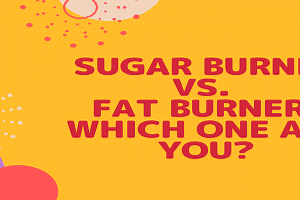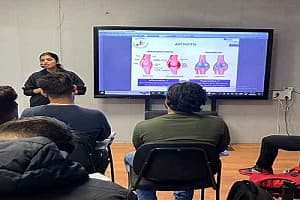Sugar burner vs. fat Burner: Which one are you?
Created On: May 15, 2021

Dr. Chirag Sethi * and Dr. Swarna Anchal **
* Director, Classic Fitness Academy, New Delhi.
** Technical Writer, Classic Fitness Academy, New Delhi.
We can burn both fat and carbs during a workout and will likely end up burning some combination of
both. But being a ‘sugar burner’ or ‘fat burner’ when working out largely comes down to how we
fuel our body and how intense the exercise.
Sugar Burner
Here the primary source of energy is glucose which gives your body no reason to burn stored
fat as the constant supply of carbohydrates fulfills the need for energy source and excess sugar
stored as fat in the body.
Identification
1) A few hours after eating, you are hungry again.
2) As time increases between meals you feel tired.
3) Cravings for more sugary foods.
4) Always feel cranky, distracted, and irritated until you eat again.
5) They struggle to lose weight and have fat around the midsection.
Reasons
This is because eating high carbohydrates that raise blood sugar and triggers hormone
insulin to bring blood sugar level down by storing that excess sugar as fat. Insulin can drop blood
sugar levels too low that you crave more carbohydrates. That’s why you have to eat more sugar to
keep your energy level up.
Even when sugar burners lose weight, they seldom lose fat. When they diet and lose weight
without losing their waist, they are making things worse.

Corrective measures
1) Include whole grains in the diet plan.
2) Cut your carbohydrates in your diet.
3) Include more protein and in every meal which keeps you fill with longer.
4) Eat more fruits, vegetables, and fibrous snacks.
5) Take low-fat dairy products.
6) Workout in the combination of weight training and cardio.
Fat Burners
Here primary fuel for energy is stored fat in the body. When you eat fewer carbohydrates,
the body eventually burns through its stored glycogen. Your body still needs the energy to power
your body and brain, so it switches to burning fat for fuel. That fat comes from your body fat and fat
in the food you eat.
Identification
1) Balanced energy level, focused all day long.
2) No cravings, and fewer snacks.
3) What you eat satisfy you for longer.
4) You can maintain a 3-6 hours gap between meals even without thinking of it.

Points to be noted
1) Your goal must be a fat burner. By eating fewer carbs, more lean protein, and healthy fats,
you train your body to burn fat for fuel.
2) As a fat burner, the body still burns carbs as fuel first and will use a small amount of sugar
from low GI (Glycemic Index) and low GL (Glycemic Load) carbs like vegetables, quinoa, or
legumes. Hence your metabolism quickly turns to your fat stores for energy.
3) As fat burns more slowly and steadily, fat burners can easily go 3-6 hours between meals
and don’t suffer from sugar or carb cravings. They also lose fat easily and experience more
steady energy.
How to Make the Change
If you recognize yourself as a sugar burner then do not cut off carbs completely from meals.
Suddenly cutting off that supply of glucose and carbs will make you feel awful, weak, tired, more
craved to sugar, and further health issues will also arise. So take help from some experts and go
for a planned diet and workout to reach your fitness and health goals.
References
1) Ho SS, Dhaliwal SS, Hills AP, and Pal S (2012). The effect of 12 weeks of aerobic, resistance,
or combination exercise training on cardiovascular risk factors in the overweight and obese
in a randomized trial . BMC Public Health 12: 704.
2) Hunter GR, Byrne NM, Sirikul B, Fernandez JR, Zuckerman PA, Darnell BE, Gower BA (2008).
Resistance training conserves fat-free mass and resting energy expenditure following weight
loss. Obesity (Silver Spring) 16(5):1045-51.
3) Loenneke JP, Wilson JM, Manninen AH, Wray ME, Barnes JT, Pujol TJ (2012). Quality protein
intake is inversely related to abdominal fat. Nutritional Metabolism (London) 9(1):5.
4) Mackie AR, Rafiee H, Malcolm P, Salt L and van Aken G (2013). Specific food structures
suppress appetite through reduced gastric emptying rate. American Journal of Physiology,
Gastrointestinology, and Liver Physiology 304(11): G1038–G1043.
5) Anari R, Amani R, Veissi M (2017). Sugar-sweetened beverages consumption is associated
with abdominal obesity risk in diabetic patients. Diabetes Metabolic Syndromes 2:S675-
S678.
6) Burton-Freeman B (2000) Dietary fiber and energy regulation.
7) Journal of Nutrition 2: 272S-275.
8) Newby PK, Maras J, Bakun P, Muller D, Ferrucci L, and Tucker KL (2007). Intake of whole
grains, refined grains, and cereal fiber measured with 7-d diet records and associations with
risk factors for chronic disease. American Journal of Clinical Nutrition 86(6): 1745–1753.
* Director, Classic Fitness Academy, New Delhi.
** Technical Writer, Classic Fitness Academy, New Delhi.
We can burn both fat and carbs during a workout and will likely end up burning some combination of
both. But being a ‘sugar burner’ or ‘fat burner’ when working out largely comes down to how we
fuel our body and how intense the exercise.
Sugar Burner
Here the primary source of energy is glucose which gives your body no reason to burn stored
fat as the constant supply of carbohydrates fulfills the need for energy source and excess sugar
stored as fat in the body.
Identification
1) A few hours after eating, you are hungry again.
2) As time increases between meals you feel tired.
3) Cravings for more sugary foods.
4) Always feel cranky, distracted, and irritated until you eat again.
5) They struggle to lose weight and have fat around the midsection.
Reasons
This is because eating high carbohydrates that raise blood sugar and triggers hormone
insulin to bring blood sugar level down by storing that excess sugar as fat. Insulin can drop blood
sugar levels too low that you crave more carbohydrates. That’s why you have to eat more sugar to
keep your energy level up.
Even when sugar burners lose weight, they seldom lose fat. When they diet and lose weight
without losing their waist, they are making things worse.

Corrective measures
1) Include whole grains in the diet plan.
2) Cut your carbohydrates in your diet.
3) Include more protein and in every meal which keeps you fill with longer.
4) Eat more fruits, vegetables, and fibrous snacks.
5) Take low-fat dairy products.
6) Workout in the combination of weight training and cardio.
Fat Burners
Here primary fuel for energy is stored fat in the body. When you eat fewer carbohydrates,
the body eventually burns through its stored glycogen. Your body still needs the energy to power
your body and brain, so it switches to burning fat for fuel. That fat comes from your body fat and fat
in the food you eat.
Identification
1) Balanced energy level, focused all day long.
2) No cravings, and fewer snacks.
3) What you eat satisfy you for longer.
4) You can maintain a 3-6 hours gap between meals even without thinking of it.

Points to be noted
1) Your goal must be a fat burner. By eating fewer carbs, more lean protein, and healthy fats,
you train your body to burn fat for fuel.
2) As a fat burner, the body still burns carbs as fuel first and will use a small amount of sugar
from low GI (Glycemic Index) and low GL (Glycemic Load) carbs like vegetables, quinoa, or
legumes. Hence your metabolism quickly turns to your fat stores for energy.
3) As fat burns more slowly and steadily, fat burners can easily go 3-6 hours between meals
and don’t suffer from sugar or carb cravings. They also lose fat easily and experience more
steady energy.
How to Make the Change
If you recognize yourself as a sugar burner then do not cut off carbs completely from meals.
Suddenly cutting off that supply of glucose and carbs will make you feel awful, weak, tired, more
craved to sugar, and further health issues will also arise. So take help from some experts and go
for a planned diet and workout to reach your fitness and health goals.
References
1) Ho SS, Dhaliwal SS, Hills AP, and Pal S (2012). The effect of 12 weeks of aerobic, resistance,
or combination exercise training on cardiovascular risk factors in the overweight and obese
in a randomized trial . BMC Public Health 12: 704.
2) Hunter GR, Byrne NM, Sirikul B, Fernandez JR, Zuckerman PA, Darnell BE, Gower BA (2008).
Resistance training conserves fat-free mass and resting energy expenditure following weight
loss. Obesity (Silver Spring) 16(5):1045-51.
3) Loenneke JP, Wilson JM, Manninen AH, Wray ME, Barnes JT, Pujol TJ (2012). Quality protein
intake is inversely related to abdominal fat. Nutritional Metabolism (London) 9(1):5.
4) Mackie AR, Rafiee H, Malcolm P, Salt L and van Aken G (2013). Specific food structures
suppress appetite through reduced gastric emptying rate. American Journal of Physiology,
Gastrointestinology, and Liver Physiology 304(11): G1038–G1043.
5) Anari R, Amani R, Veissi M (2017). Sugar-sweetened beverages consumption is associated
with abdominal obesity risk in diabetic patients. Diabetes Metabolic Syndromes 2:S675-
S678.
6) Burton-Freeman B (2000) Dietary fiber and energy regulation.
7) Journal of Nutrition 2: 272S-275.
8) Newby PK, Maras J, Bakun P, Muller D, Ferrucci L, and Tucker KL (2007). Intake of whole
grains, refined grains, and cereal fiber measured with 7-d diet records and associations with
risk factors for chronic disease. American Journal of Clinical Nutrition 86(6): 1745–1753.






